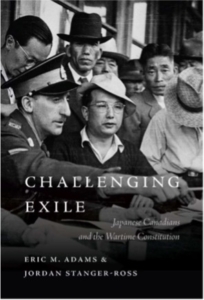
BOOK REVIEW
Challenging Exile is Essential Reading for History Buffs

- Title: Challenging Exile: Japanese Canadians and the Wartime Constitution
- Authors: Eric Adams and Jordan Stanger-Ross
- Genre: Non-fiction
- Publisher: UBC Press
- Pages: 360
 In the year 1946, almost 4,000 Canadians of Japanese ancestry were deported from British Columbia to a Japan that had been laid waste by war. Most of those deported were young people who had been born in Canada, or older people who had obtained citizenship.
In the year 1946, almost 4,000 Canadians of Japanese ancestry were deported from British Columbia to a Japan that had been laid waste by war. Most of those deported were young people who had been born in Canada, or older people who had obtained citizenship.
In Challenging Exile: Japanese Canadians and the Wartime Constitution, Eric Adams, a law professor at University of Alberta, and Jordan Stanger-Ross, a history professor at University of Victoria, tell the story of those forced by their own government to leave their country for another land.
Many of us who know about the internment of Japanese Canadians in the Second World War know little or nothing about these deportations after the war ended. Challenging Exile tells that story.
Although the book is principally a legal history of the federal government’s decision to expel its own citizens and of the judicial rulings that upheld that decision, the authors take great care to include the voices of those who endured internment and then exile. This combination of scholarly research and personal narrative makes Challenging Exile especially compelling, and essential reading for anyone who cares about our country’s past.
Even before the Second World War, Japanese and other Asian Canadians living in British Columbia endured levels of racism that were shocking even by the standards of the time. They were barred from dozens of occupations – everything from practising law to being a manager at a mine. Those who had citizenship, through birth or naturalization, were denied both the provincial and federal right to vote in that province.
Nonetheless, a community of more than 20,000 Japanese Canadians took root in B.C. They might have owned or worked at a store, a farm, a fishing vessel. They invested in homes and businesses. They loved Canada, despite the racism they endured. It must never have occurred to them that the government and the laws they obeyed would one day take from them everything they owned or had achieved.
In December, 1941, after the attack on Pearl Harbor, Canada joined its allies in declaring war on Japan. The federal and provincial governments feared that Japanese Canadians living on the West Coast would collude with the enemy, though there was not the slightest evidence to support that fear. In any case, many white British Columbians demanded that the Japanese be removed from their midst.
About 22,000 Japanese Canadians were stripped of their civil rights and forced into internment camps. The government promised to look after their property, but instead sold off almost everything, usually at ridiculously low prices. Other allied governments also interned those of Japanese descent, but Canada’s treatment was particularly harsh.
In 1944, with the defeat of Japan now certain, the federal government of prime minister Mackenzie King faced a problem. The Japanese internees had been dispossessed of their property and other assets, and in any case would not be welcomed by the white people in the communities where they had once lived. “Rather than undo the knot in which they had bound themselves and Japanese Canadians, they tied themselves into still more tangles,” the authors write. “As a solution to the problem of internment, they proposed exile.”
Officials presented the detainees with a stark choice. They could migrate east of the Rockies to other parts of Canada, or they could sign a document agreeing to be exiled to Japan. Remaining in British Columbia was forbidden. “Two options were presented: east or out.”
More than 40 per cent of those confronted with this choice signed the form agreeing to be sent to Japan. Some were sick of the persecution they had endured and wanted to be rid of Canada. But many others, probably most, signed in confusion or under duress, and soon changed their minds. The government was determined to deport them regardless.
Under the War Measures Act, the federal cabinet had virtually limitless power to act as it saw fit, and it saw fit to deport these people, even though about three-quarters of those interned were Canadian citizens, either born or naturalized. In December, 1945, even though the war was over, cabinet issued three Orders-in-Council, authorizing the deportation of those who had purportedly agreed to expulsion.
Those cabinet orders incensed not only Japanese Canadians, but others who considered the forced deportation of Canadian citizens an outrage. The Co-operative Committee on Japanese Canadians (CCJC), a group of white religious and civil-liberty leaders, worked with Japanese community leaders to challenge the orders in court. The government, eager to speed through any legal obstructions so that the deportations could get under way, referred the matter directly to the Supreme Court.
The CCJC lawyers maintained that the government’s power of deportation could not include deporting Canadian citizens. The government maintained that it could.
The Supreme Court ruled in the government’s favour, as did the Judicial Committee of the Privy Council in London, at that time Canada’s highest appellate court. The judges believed that in a national emergency, governments should have all necessary powers to protect the state.
This being a legal history, the authors explore the two court cases in detail. I found the arguments on both sides fascinating, but some readers may prefer to pass over these pages lightly.
In general, the authors’ prose is clean and uncluttered. Their sense of controlled anger at the blatant racism and injustice of the Canadian government toward Japanese Canadians infuses the book. They take care to ensure that those who suffered are given voice.
In the months that the case took to make it through the Supreme Court and the Privy Council, public attitudes toward the deportations started to change. Newspapers questioned the federal government’s decision to send its own citizens to a foreign, defeated land. The Winnipeg Free Press was the most forceful, damning the exile policy as rooted in the “intolerable doctrine of racism” and asking: “What does Canadian citizenship mean if it is not recognized everywhere in the country, and it does not give the right to go and live anywhere?”
The Globe and Mail at first supported the exile policy but later changed its mind. “Legality is one thing,” its editors declared, but “Ottawa still faces a moral responsibility from which it cannot escape behind a cloak of legalism.”
In the House of Commons, Conservative MP John Diefenbaker called on Parliament to enact a Bill of Rights to protect Canadian citizens. Even some Liberal MPs voiced concerns.
Faced with growing opposition, the federal government wound down the deportation program. The last vessel departed Christmas Eve, 1946. “A new language of rights had changed the terms of the debate,” the author observed, “not, as some might have assumed, in court, but in Parliament and newspapers and living rooms.”
That new language of rights found expression in the Bill of Rights enacted by the Diefenbaker government in 1960 and in the Charter of Rights and Freedoms that became part of the constitution in 1982 under Pierre Trudeau.
Canada entrenched those rights in part because they had been so easily stripped from Japanese Canadians. They did not receive the right to vote federally, regardless of province of residence, until 1948. They were not permitted to live in British Columbia’s coastal areas until 1949.
The 3,964 who were deported faced a Japan devastated by war. They suffered hunger and cold and disease and other deprivations. Some eventually established themselves, in some cases by finding work with the occupying American forces. But about half eventually returned to Canada, despite efforts by the federal government to stop them. Most of those who returned had been taken to Japan as children.
Roy Uyeda came back in his mid-20s, after 12 years in Japan. “What Canada did to us and how, at the start of WWII and after … directed and shaped my life in its entirety to this very day,” he told one of the authors in 2024. “And the hunger and starving I ‘tasted’ as a youngster in postwar Japan etched an everlasting, deep mark on my soul.”
The everlasting, deep mark that so many Japanese Canadian souls suffered at the hands of the government and of the Canadian people remains one of the darkest chapters in the story of this land.
Eric Adams and Jordon Stanger-Ross have given us a superb chronicle of those times.
© Copyright 2025 The Globe and Mail Inc. All rights reserved. The Globe and Mail and globeandmail.com are divisions of The Globe and Mail Inc., The Globe and Mail Centre, 351 King Street East, Suite 1600, Toronto, ON M5A 0N19. Andrew Saunders, President and CEO.

 Instagram
Instagram